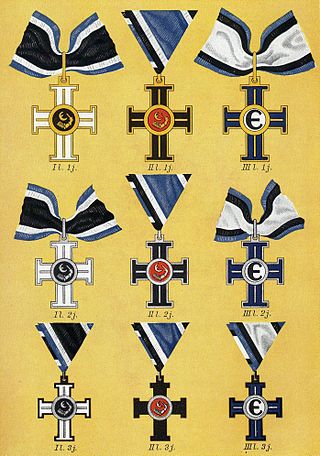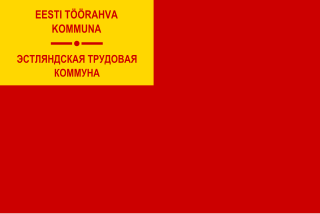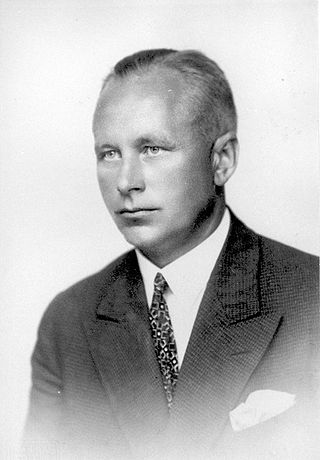| |||||
| Decades: | |||||
|---|---|---|---|---|---|
| See also: | |||||
This article lists events that occurred during 1919 in Estonia .
| |||||
| Decades: | |||||
|---|---|---|---|---|---|
| See also: | |||||
This article lists events that occurred during 1919 in Estonia .
1919 (MCMXIX) was a common year starting on Wednesday of the Gregorian calendar and a common year starting on Tuesday of the Julian calendar, the 1919th year of the Common Era (CE) and Anno Domini (AD) designations, the 919th year of the 2nd millennium, the 19th year of the 20th century, and the 10th and last year of the 1910s decade. As of the start of 1919, the Gregorian calendar was 13 days ahead of the Julian calendar, which remained in localized use until 1923.

Otto August Strandman was an Estonian politician, who served as prime minister (1919) and State Elder of Estonia (1929–1931). He was one of the leaders of the centre-left Estonian Labour Party, that saw its biggest support after the 1919 and 1920 elections. Strandman was a key figure in composing the radical land reform law and the 1920 Constitution. He also served as Minister of Agriculture (1918–1919), Minister of Justice, Minister of Finance (1924), Minister of Foreign Affairs and Minister of War (1919). While he was holding the office of the Minister of Finance, he stabilized the economy and managed to avoid hyperinflation. Strandman served as the speaker of the Estonian Provincial Assembly in 1917–1918, and as speaker of the newly independent country's parliament (Riigikogu) in 1921. He was also a diplomat, serving as the Estonian envoy in Warsaw, Poland (1927–1929), and in Paris, France (1933–1939).

The Estonian War of Independence, also known as the Estonian Liberation War, was a defensive campaign of the Estonian Army and its allies, most notably the United Kingdom, against the Soviet Russian westward offensive of 1918–1919 and the 1919 aggression of the pro–German Baltische Landeswehr. The campaign was the struggle of the newly established democratic nation of Estonia for independence in the aftermath of World War I. It resulted in a victory for Estonia and was concluded in the 1920 Treaty of Tartu.

Konstantin Päts was an Estonian statesman and the country's president in 1938–1940. Päts was one of the most influential politicians of the independent democratic Republic of Estonia, and during the two decades prior to World War II he also served five times as the country's prime minister. After the 16–17 June 1940 Soviet invasion and occupation of Estonia, President Päts remained formally in office for over a month, until he was forced to resign, imprisoned by the new Stalinist regime, and deported to the USSR, where he died in 1956.

The Estonian Cross of Liberty is a military decoration established by the Prime Minister of Estonia, Konstantin Päts, on 24 February 1919 to honor the people for their services during the Estonian War of Independence. The Estonian Cross of Liberty has three divisions, each in three classes. Division I was granted for military leadership, division II for personal courage and division III for civilian services. The division and class of the Estonian Cross of Liberty is usually added to the name of the recipient in the form of post-nominal letters. The 1st class of the II division of the Estonian Cross of Liberty was never granted. Although still mentioned in the list of Estonian state decorations by the president of the republic, the bestowal of the Estonian Cross of Liberty was terminated on 19 June 1925.

Jüri Uluots was an Estonian prime minister, journalist, prominent attorney and distinguished Professor and Dean of the Faculty of Law at the University of Tartu.

The Mountainous Republic of the Northern Caucasus (MRNC), also referred to as the United Republics of the North Caucasus, Mountain Republic, or the Republic of the Mountaineers, was a state in Eurasia and encompassing the entirety of the North Caucasus that emerged during the Russian Civil War and existed from 1918 to 1922. It formed as a consolidation of various Caucasian ethnic groups, including the Circassians, Chechens, Karachays, Ossetians, Balkars, Ingush, and Dagestanis.

Johannes Vares was an Estonian and Soviet poet, medical doctor, and politician.
The Estonian resistance movement was an underground movement to resist the occupation of Estonia by Nazi Germany, 1941–1944 during World War II. Due to the unusually benign measures implemented in Estonia by the German occupation authorities, especially in contrast to the preceding harsh Soviet occupation of Estonia (1940–1941), the movement was slower to develop effective tactics on a wide scale than in other occupied countries.

The Estonian Worker's Commune was a government claiming the Bolshevik-occupied parts of Republic of Estonia as its territories during the Estonian War of Independence and the Russian Civil War. It was recognised as an independent state only by Russian SFSR on December 7th, 1918.

Tapa Bey Ortsu Tchermoev was a North Caucasian statesman of Chechen origin, general, oil magnate and the first prime minister of the Mountainous Republic of the Northern Caucasus. He was in office from 11 May 1918 until December 1918. His official title was General Tchermoeff, Prime Minister of the Mountainous Republic of the Northern Caucasus.

Otto Tief was an Estonian politician, military commander, and a lawyer.

The British campaign in the Baltic 1918–1919 was a part of the Allied intervention in the Russian Civil War. The codename of the Royal Navy campaign was Operation Red Trek. The intervention played a key role in enabling the establishment of the independent states of Estonia and Latvia. It failed to secure the control of Petrograd by White Russian forces, which was one of the main goals of the campaign.

Jüri Vilms was a member of the Estonian Salvation Committee and the first Deputy Prime Minister of the Republic of Estonia. Empowered by Maapäev the Salvation Committee issued the Estonian Declaration of Independence on February 24, 1918 in the middle of a political power vacuum created by the retreating Russian and advancing German troops during World War I. The German forces taking over the country didn't recognize the independence of Estonia. The Salvation Committee went underground, Jüri Vilms volunteered to go to Finland to take funds and instructions to the Estonian missions working to get diplomatic recognition for the newly sovereign nation. According to an "official" version, he was captured on reaching the Finnish coast and executed by German troops in Helsinki. According to the latest research Jüri Vilms may have been executed by a unit of the Swedish Brigade in Hauho. Estonia gained its independence after the German troops were withdrawn from Estonia due to the German Revolution and following Estonian War of Independence ended with Peace Treaty of Tartu.
Vandu is a village in Kadrina Parish, Lääne-Viru County, in northeastern Estonia.
The Estonian Labour Party was a political party in Estonia. It was formed in 1919 by a merger of the Radical Socialist Party and the Social Travaillist Party, and ceased to exist in 1932, when it merged with other centrist parties to form the National Centre Party. It was a member of government coalitions between 1919 and 1925, and again from 1927 until 1931.
The Estonian Constituent Assembly was elected on 5–7 April 1919, called by the Estonian Provisional Government during the Estonian War of Independence.

Danish-Baltic Auxiliary Corps was a Danish company of military volunteers, established 1919 as a non-governmental initiative to help in the Estonian and Latvian war of independence. It was originally planned to send several companies to help, but due to the success of war, only one company was sent, Compagnie Borgelin. The company consisted of approximately 200 men with Captain Iver de Hemmer Gudme as corps commander and Captain Richard Gustav Borgelin as company commander.
This article covers the timeline of the Estonian War of Independence (1918−1920) and a few key events in the prelude and aftermath of the war.